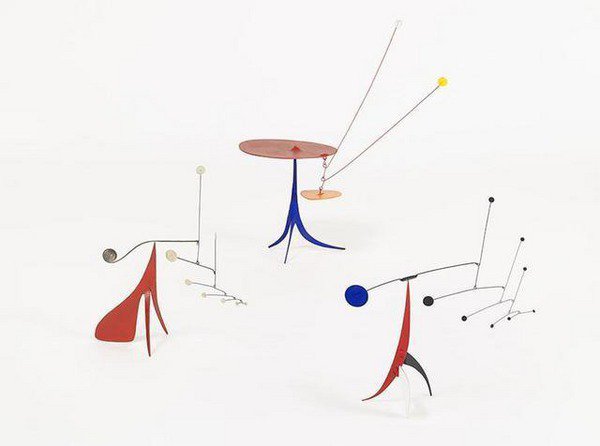Alexander Calder
dal 21/4/2015 al 12/6/2015
Segnalato da
21/4/2015
Alexander Calder
Dominique Levy, New York
Multum in Parvo presents Calder's small sculptures in an environment conceived by internationally admired architect Santiago Calatrava.

Beginning April 22nd, Dominique Lévy is pleased to present Alexander Calder. MULTUM IN PARVO, an exhibition of over forty rare small-scale sculptures by an American master, installed in an environment conceived for them by the architects Santiago and Gabriel Calatrava.
Taking its title, MULTUM IN PARVO, from the Latin phrase meaning “much in little,” the exhibition explores the ways in which Alexander Calder’s most diminutive works, ranging from thumb-sized to thirty inches tall, achieve monumental impact. These sculptures often share the same physical properties as Calder’s largest stabiles and mobiles, but via the tiniest details. Presented in collaboration with the Calder Foundation, the exhibition at Dominique Lévy casts a spotlight for the first time on the complex and often surprising relationship between scale and size in Calder’s oeuvre over a period of more than thirty years. The show includes one of his smallest sculptures from the 1950s that measures just over one inch high—a miracle of miniature.
MULTUM IN PARVO presents Calder’s small sculptures in an environment conceived by internationally admired architect Santiago Calatrava. Unfolding over the gallery’s two exhibition floors, Calatrava’s design honors the beauty and delicacy of Calder’s smaller sculptures, and seeks to bring visitors into close contact with the tiniest details and gestures that give these works their magic.
The exhibition is accompanied by a fully illustrated catalogue featuring archival material, installation photography, and original sketches by Santiago Calatrava that reveal the architectural process in response to Calder’s ideas and work. The book also includes commissioned essays by Jed Perl, art historian and author currently at work on the first full-length biography of Alexander Calder, and Paul Goldberger, Pulitzer Prize-winning architecture critic, as well as poems by Karl Shapiro and John Updike.
ABOUT THE ARTIST
Alexander Calder (1898–1976) utilized his innovative genius to profoundly change the course of modern art. Born in a family of celebrated, though more classically trained artists, he began by developing a new method of sculpting: by bending and twisting wire, he essentially "drew" three-dimensional figures in space. He is renowned for the invention of the mobile, whose suspended, abstract elements move and balance in changing harmony. Coined by Marcel Duchamp in 1931, the word mobile refers to both “motion” and “motive” in French. The earliest mobiles moved by a system of cranks and motors, although these mechanics were virtually abandoned as Calder developed mobiles that responded to air currents, light, humidity, and human interaction. He also created stationary abstract works that Jean Arp dubbed stabiles. Major retrospectives of Calder's work during his lifetime were held at the George Walter Vincent Smith Gallery, Springfield, Massachusetts (1938); The Museum of Modern Art, New York (1943–44); Solomon R. Guggenheim Museum, New York (1964–65); The Museum of Fine Arts, Houston (1964); Musée National d'Art Moderne, Paris (1965); Fondation Maeght, Saint-Paul-de-Vence, France (1969); and the Whitney Museum of American Art, New York (1976–77). Calder died in New York in 1976 at the age of seventy-eight.
ABOUT THE ARCHITECTS
Santiago Calatrava was born in 1951 in Valencia, Spain. With degrees in architecture and civil engineering, he has become an international leader in urban design since opening his first office in Zürich in 1981. Over the next thirty-five years he has opened additional offices in Paris and New York, and completed major commissions in Argentina, Greece, Ireland, Israel, Spain, The Netherlands and the United States, among others. An architect, engineer, and artist, in 2005 an exhibition of his work was mounted at the Metropolitan Museum of Art in New York titled Santiago Calatrava: Sculpture into Architecture. In 2011 a joint work created with Frank Stella was exhibited at Berlin’s New National Gallery. Stella painted the 98-foot-long mural, The Michael Kohlaas Curtain, which was installed on the inside of a torus-shaped steel sculpture constructed by Calatrava and suspended from the ceiling of the iconic Mies Van der Rohe building. Calatrava was named a “Global Leader for Tomorrow” by the World Economic Forum in 1993, and one of the 100 most influential people by Time Magazine in 2005.
Gabriel Calatrava works with internationally acclaimed architecture and engineering firm, Santiago Calatrava. Noted for the iconic white cantilevered bridges, Calatrava's structures gracefully transform and give new life to urban landscapes in which they are built across the globe. A citizen of the world, Gabriel has studied both engineering and architecture in New York at Columbia University.
Images (From Left to Right): Untitled, c. 1952. Painted sheet metal, wire, and brass. 13 3/8 x 11 13/16 x 4 3/4 inches (34 x 30 x 12 cm). Red Toadstool, 1949. Sheet metal, wire, paint. 21 x 16 x 8 inches (53.3 x 40.6 x 20.3 cm). Eight Black Dots, c. 1950. Sheet metal, wire, paint. 15 x 12 x 5 inches (38.1 x 30.5 x 12.7 cm). © 2015 Calder Foundation, New York / Artists Rights Society (ARS), New York
Press Contact:
Andrea Schwan, Andrea Schwan Inc.
info@andreaschwan.com
Opening: thuesday 22 april 2015
Dominique Lévy | New York
909 Madison Avenue
Tue - Sat 10am to 6pm



